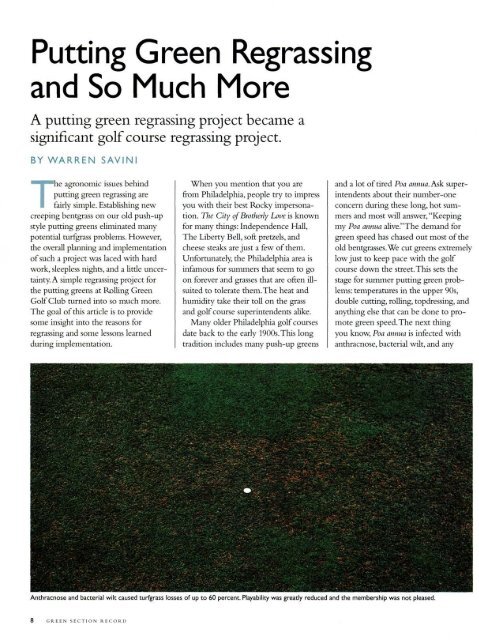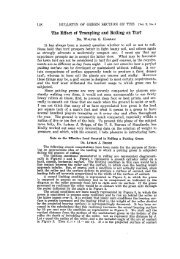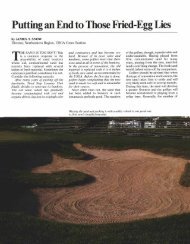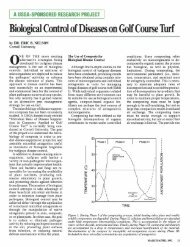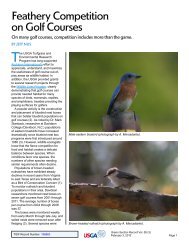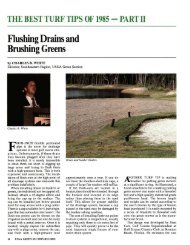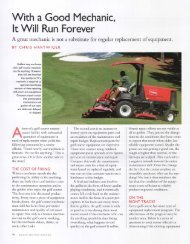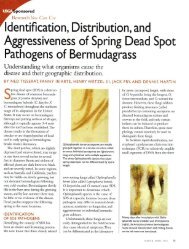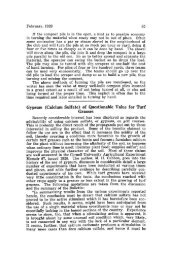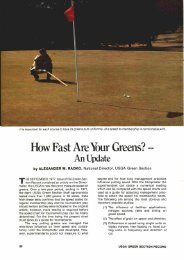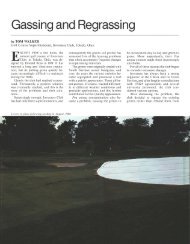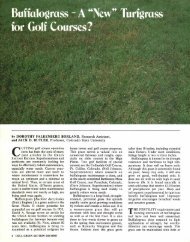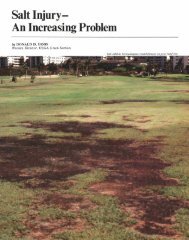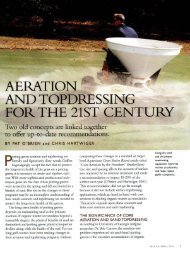Putting Green Regrassing and So Much More - USGA Green ...
Putting Green Regrassing and So Much More - USGA Green ...
Putting Green Regrassing and So Much More - USGA Green ...
You also want an ePaper? Increase the reach of your titles
YUMPU automatically turns print PDFs into web optimized ePapers that Google loves.
<strong>Putting</strong> <strong>Green</strong><br />
<strong>and</strong> <strong>So</strong> <strong>Much</strong> <strong>More</strong><br />
<strong>Regrassing</strong><br />
A putting green regrassing project became a<br />
significant golf course regrassing project.<br />
BY WARREN<br />
SAVINI<br />
e agronomic issues behind<br />
putting green regrassing are<br />
~ fairly simple. Establishing new<br />
creeping bentgrass on our old push-up<br />
style putting greens eliminated many<br />
potential turf grass problems. However,<br />
the overall planning <strong>and</strong> implementation<br />
of such a project was laced with hard<br />
work, sleepless nights, <strong>and</strong> a little uncertainty.A<br />
simple regrassing project for<br />
the putting greens at Rolling <strong>Green</strong><br />
Golf Club turned into so much more.<br />
The goal of this article is to provide<br />
some insight into the reasons for<br />
regrassing <strong>and</strong> some lessons learned<br />
during implementation.<br />
When you mention that you are<br />
from Philadelphia, people try to impress<br />
you with their best Rocky impersonation.<br />
The City if Brotherly Love is known<br />
for many things: Independence Hall,<br />
The Liberty Bell, soft pretzels, <strong>and</strong><br />
cheese steaks are just a few of them.<br />
Unfortunately, the Philadelphia area is<br />
infamous for summers that seem to go<br />
on forever <strong>and</strong> grasses that are often illsuited<br />
to tolerate them. The heat <strong>and</strong><br />
humidity take their toll on the grass<br />
<strong>and</strong> golf course superintendents alike.<br />
Many older Philadelphia golf courses<br />
date back to the early 1900s. This long<br />
tradition includes many push-up greens<br />
<strong>and</strong> a lot of tired Poa annua. Ask superintendents<br />
about their number-one<br />
concern during these long, hot summers<br />
<strong>and</strong> most will answer, "Keeping<br />
my Poa annua alive."The dem<strong>and</strong> for<br />
green speed has chased out most of the<br />
old bentgrasses. We cut greens extremely<br />
low just to keep pace with the golf<br />
course down the street. This sets the<br />
stage for summer putting green problems:<br />
temperatures in the upper 90s,<br />
double cutting, rolling, topdressing, <strong>and</strong><br />
anything else that can be done to promote<br />
green speed. The next thing<br />
you know, Poa annua is infected with<br />
anthracnose, bacterial wilt, <strong>and</strong> any<br />
Anthracnose <strong>and</strong> bacterial wilt caused turfgrass losses of up to 60 percent. Playabilitywas greatly reduced <strong>and</strong> the membership was not pleased.<br />
8 GREEN SECTION RECORD
number of other maladies. Such was the<br />
case at Rolling <strong>Green</strong> Golf Course, <strong>and</strong><br />
the greens failed miserably. We all know<br />
Paa annua can be pushed too far, but<br />
everyday expectations throw us in the<br />
line of fire <strong>and</strong> away from sane<br />
agrononucs.<br />
Rolling <strong>Green</strong> Golf Course was<br />
designed by William Flynn <strong>and</strong> opened<br />
in 1926. I accepted the superintendent's<br />
job in late winter of 2001. The greens<br />
had had a serious bout of anthracnose<br />
the previous summer. I came from a<br />
course with 100 percent Paa annua<br />
greens. When the search committee<br />
from Rolling <strong>Green</strong> toured my golf<br />
course during the hiring process (in<br />
October, not mid-August!), the committee<br />
saw smooth, fast Paa annua<br />
greens. I guess that sealed the deal,<br />
<strong>and</strong> I was hired.<br />
THE PROBLEM STARTS<br />
Anytime you take a new superintendent's<br />
position, it is a challenge. When<br />
anthracnose is involved on Paa annua<br />
putting greens, it is a huge challenge. In<br />
March of 2001, we noticed small yellow<br />
spots infecting our Paa annua. A sample<br />
sent to a diagnostic lab confirmed that<br />
anthracnose was the culprit. All of the<br />
appropriate fungicides you can think of<br />
were applied to control the disease. By<br />
mid-April, the anthracnose was under<br />
control, <strong>and</strong> I was thinking that we had<br />
just survived the first glitch of the<br />
season. Little did I know what was still<br />
to come.<br />
In mid-May, dime-sized spots started<br />
to form on the high <strong>and</strong> dry areas of<br />
the Paa annua greens. Heavy spring<br />
rains saw these spots progress to the low<br />
areas of the greens <strong>and</strong> coalesce into<br />
larger areas that mimicked anthracnose.<br />
A turf sample was sent to the University<br />
of Maryl<strong>and</strong>, <strong>and</strong> the diagnosis came<br />
back as bacterial wilt. Every known<br />
anthracnose fungicide was used, <strong>and</strong><br />
now we had to spray copper hydroxide<br />
to control bacterial wilt. <strong>USGA</strong> agronomists,<br />
turfgrass pathologists, <strong>and</strong> golf<br />
course superintendents all came to see<br />
the devastation.<br />
Many trees were removed to improve sunlight penetration prior to regrassing the greens. Several<br />
greens struggled during the summer because more trees should have been removed.<br />
By the end of June, turf loss on all of<br />
the greens ranged from 10 to 60 percent.<br />
A plant pathologist was brought<br />
in to make recommendations to the<br />
<strong>Green</strong> Committee. These discussions<br />
provided background information for<br />
the <strong>Green</strong> Committee to make an<br />
educated decision about the problems<br />
<strong>and</strong> potential solutions. One option was<br />
to continue spraying fungicides, overseed<br />
the greens with creeping bentgrass<br />
in August in an effort to increase creeping<br />
bentgrass populations <strong>and</strong> pray that<br />
the problems did not repeat themselves.<br />
This option was filled with a great deal<br />
of uncertainty. The second option was<br />
to close the course in August, fumigate<br />
the greens with methyl bromide, <strong>and</strong><br />
establish one of the newer creeping<br />
bentgrass varieties that are more resistant<br />
to anthracnose <strong>and</strong> tolerant of low<br />
mowing<br />
heights.<br />
THE DECISION<br />
Mter the dust settled, the committee<br />
looked at playability, lost revenue, canceled<br />
outings, <strong>and</strong> club championships.<br />
Expectations dictated that we choose<br />
the best option for the future of the<br />
club. In early July, the Board of Directors<br />
voted unanimously to close the course<br />
in early August to fumigate <strong>and</strong> regrass<br />
the greens. My head was spinning. It<br />
was my first summer <strong>and</strong> the greens<br />
were hit with every problem in the<br />
book. What did I get myself into this<br />
time? Full membership support during<br />
this time of crisis helped the situation.<br />
Unfortunately, we had only three weeks<br />
to pull the project together. This business<br />
has a way of humbling you very<br />
quickly, <strong>and</strong> I was humbed once again.<br />
Such is life when working with nature.<br />
Preparations began the following<br />
morning. We scheduled visits to other<br />
golf courses in the area that had gone<br />
through similar regrassing projects <strong>and</strong><br />
evaluated their methods <strong>and</strong> results.<br />
These trips turned out to be valuable, as<br />
there is no substitute for experience.<br />
Creeping bentgrass variety, seedbed<br />
preparation, <strong>and</strong> satisfaction with the<br />
final product were all discussed. Every<br />
course had one common recommendation:<br />
remove enough trees to improve<br />
direct sunlight penetration to the greens.<br />
Bad growing environments lead to bad<br />
greens, regardless of the grass used.<br />
The scope of the project exp<strong>and</strong>ed.<br />
Not that regrassing the greens was not<br />
enough; the list of renovation ideas kept<br />
growing since the course would be<br />
closed. <strong>Regrassing</strong> the fairways <strong>and</strong> tees,<br />
practice tee expansion, creek restoration,<br />
<strong>and</strong>, of course, tree removal were all<br />
discussed. Time was of the essence. It<br />
MARCH-APRIL 2003 9
The greens held up to heavy play (180<br />
to 210 rounds per day). The collars<br />
thinned significantly on many of the<br />
greens, providing more stress for me.<br />
<strong>Green</strong>s located in pocketed areas prowas<br />
already the second week of July.<br />
Contractors still needed to be locked in<br />
for the project to get started in early<br />
August.<br />
The final proposal included the<br />
removal of 72 trees <strong>and</strong> the heavy<br />
pruning of 20 more, fumigation <strong>and</strong><br />
regrassing of the greens to creeping<br />
bentgrass, fumigation <strong>and</strong> leveling of all<br />
tees, fumigation <strong>and</strong> regrassing of 14<br />
acres of fairways <strong>and</strong> all approaches,<br />
creek restoration on the<br />
seventh <strong>and</strong> eighth holes, <strong>and</strong><br />
reconstruction of the 16th<br />
green to <strong>USGA</strong><br />
specifications. This was no<br />
longer a simple" gas <strong>and</strong><br />
regrass" project. Hiring<br />
By the middle of September all<br />
greens, tees, <strong>and</strong> fairways were seeded.<br />
We had a great fall with an extended<br />
Indian summer. There was an initial<br />
concern that heavy pesticide use for<br />
disease control was inhibiting germination.Waiting<br />
for germination on the<br />
greens was the most gut-wrenching<br />
aspect of the project. What would<br />
happen if the grass did not grow?<br />
Fortunately, I never had to answer this<br />
contractors to start this<br />
project was a major task. The<br />
logistics required cooperation<br />
from all parties involved for<br />
this project to be a success.<br />
What started as a discussion<br />
of putting green regrassing<br />
had grown<br />
When the fumigation tarps were applied in early August 200 I,<br />
into a maior<br />
:J the finality of what was about to happen began to really sink in.<br />
project, although the putting<br />
greens were still the focus. Fortunately,<br />
things came together rapidly on a tight<br />
timetable.<br />
The greens were fumigated with<br />
methyl bromide <strong>and</strong> seeded on<br />
schedule during the second week of<br />
August. Trees were coming down <strong>and</strong><br />
trees, fairways, <strong>and</strong> approaches were<br />
fumigated with Basamid <strong>and</strong> seeded to<br />
creeping bentgrass.Visits by <strong>USGA</strong><br />
agronomists <strong>and</strong> area superintendents<br />
who had gone through similar projects<br />
were always welcome. While you think<br />
that you can pull together a project of<br />
this magnitude in a short amount of<br />
time, doubt creeps into your mind <strong>and</strong><br />
you wonder if everything will come<br />
together. The support<br />
of your peers<br />
greatly helps pull you through the<br />
tough times. One lesson I learned is not<br />
to be afraid to ask for help. Turfgrass<br />
academia, <strong>USGA</strong> agronomists, <strong>and</strong> area<br />
superintendents are all resources at your<br />
fingertips. All you need to do is ask to<br />
get input. I used all of these resources<br />
before, during, <strong>and</strong> after this project.<br />
question. Seed germination was slow in<br />
areas with insufficient irrigation coverage,<br />
but h<strong>and</strong> watering helped with this<br />
problem. During grow-in, the shortcomings<br />
of an irrigation system become<br />
obvious. This is just one more problem<br />
that had to be addressed. Insufficient<br />
tree removal had more to do with slow<br />
germination<br />
than anything. As winter<br />
approached, we felt that the project was<br />
successful. With all the projects completed,<br />
it was time to recharge my<br />
batteries <strong>and</strong> prepare for the spring.<br />
The course reopened for play on<br />
April 13th. For the most part, the members<br />
were pleased with the regrassing<br />
<strong>and</strong> other projects. The summer heat of<br />
2002 started in the third week of June.<br />
Record heat coupled with significant<br />
water restrictions ensued - just what I<br />
didn't need - a long, hard summer.<br />
vided problems throughout the summer.<br />
This took me back to our visits to other<br />
golf courses. They told us to remove as<br />
many trees as needed, <strong>and</strong> they pointed<br />
out that bentgrasses need more sunlight<br />
than Poa annua. Additional tree removal<br />
was scheduled for the winter of 2002-<br />
2003. By the fall of2002, the greens<br />
had recovered from the summer. Overall,<br />
the entire project was a great success,<br />
<strong>and</strong> we look forward to next summer.<br />
SUMMARY<br />
<strong>Regrassing</strong> greens to creeping<br />
bentgrass can eliminate a lot of<br />
problems. Although these new<br />
grasses come with challenges of<br />
their own, the new problems<br />
are more manageable than<br />
anthracnose <strong>and</strong> bacterial wilt!<br />
The entire process was stressful<br />
<strong>and</strong> not as easy as some may<br />
think.<br />
Is regrassing right for your<br />
golf course? The greens will<br />
answer that question for you.<br />
Repeated bouts of anthracnose,<br />
summer patch, <strong>and</strong> maybe a little<br />
bacterial wilt for good measure may<br />
indicate that you are fighting a losing<br />
battle. If expectations cannot be met,<br />
regrassing should be considered. Take<br />
the time to educate yourself with facts<br />
<strong>and</strong> figures about regrassing. Use<br />
consultants from universities, the <strong>USGA</strong>,<br />
or the private sector to provide input.<br />
Course officials seem to be more willing<br />
to act on recommendations from a<br />
third party.<br />
The most important thing is to communicate<br />
with your <strong>Green</strong> Committee<br />
<strong>and</strong> course officials. Keep all lines of<br />
communication open <strong>and</strong> provide continuous<br />
updates on progress. Be prepared<br />
for a very trying time during the<br />
actual implementation of any major<br />
project. In spite of the best planning,<br />
headaches <strong>and</strong> surprises will occur.<br />
However, once completed, the end<br />
result in our case was very rewarding.<br />
WARREN SAVINI,JR., is the golf course<br />
superintendent at Rolling <strong>Green</strong> Golf Club.<br />
10 GREEN SECTION RECORD


